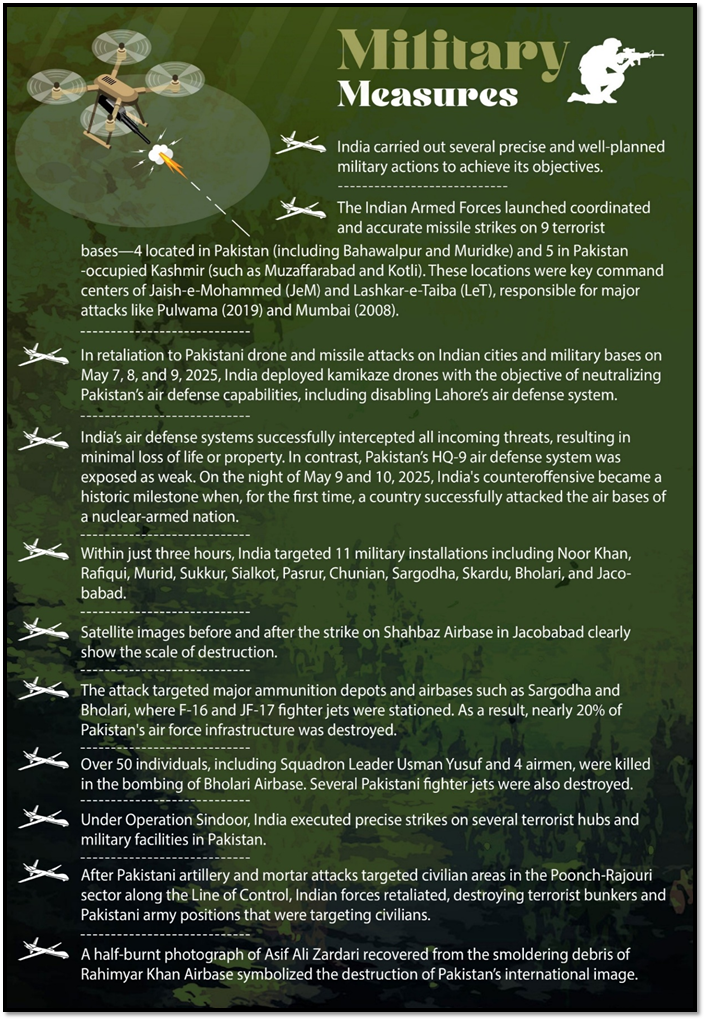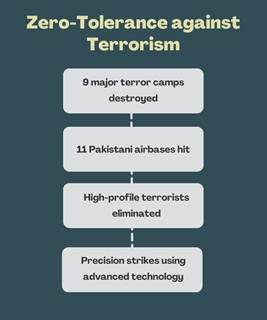Operation SINDOOR: India’s Strategic Clarity and Calculated Force
Operation SINDOOR: India’s Strategic Clarity and Calculated Force
Introduction:
On April 22, terror struck Pahalgam. Pakistan-backed attackers stormed a village, asked people their religion, and killed them, resulting in 26 deaths. A clear attempt to incite communal violence, this marked a shift, from cross-border attacks to dividing India from within. In response, India launched Operation SINDOOR to destroy the terror bases behind the attack. But Pakistan hit back harder. Over the next week, it used drones and shelling to target religious sites. The Shambhu Temple in Jammu, the Gurdwara in Poonch, and Christian convents were attacked. These were not random strikes. They were part of a plan to break India’s unity.
Purpose of Operation SINDOOR:
Intelligence and Target Selection:
Operational Ethics and Restraint:
During the first press briefing on May 7, India clarified its response as focused, measured and non-escalatory. It was specifically mentioned that Pakistani military establishments had not been targeted. It was also reiterated that any attack on military targets in India will invite a suitable response. Foreign Secretary Vikram Misri, across multiple press briefings on May 8, 9, and 10, laid bare India’s plan of action and the full extent of Pakistan’s designs.
India’s Retaliatory Response: India conducted retaliatory strikes on Radar installations in Lahore and Radar facilities near Gurjanwala destroyed.
Ceasefire: Inflicted by this heavy damage, Pakistan’s Director General of Military Operations (DGMO) called the Indian DGMO and It was agreed between them that both sides would stop all firing and military action on land and in the air and sea with effect from 1700 hours Indian Standard Time on 10th May 2025.
Pakistani Response after ceasefire: Even after ceasefire, Wave of UAVs and small drones intruded into Indian civilian and military areas. These drones were successfully intercepted.
The Indian Armed Forces gave a befitting response to Pakistan’s intrusion. Further, all field commanders have been authorized to take appropriate action in case of any ceasefire violation.
Additionally, being in the digital age, warfare transcends traditional battlegrounds. Alongside military operations, a fierce information war has been ongoing online. Following the commencement of Operation SINDOOR, India found itself targeted by an aggressive campaign launched by Pakistan- full of lies and misinformation. The aim was to distort the truth, mislead the global public and reclaim lost narrative ground through a storm of misinformation. However, India has been proactively responding and dissipating misinformation with facts, transparency, showcasing strong digital vigilance. Rather than reacting emotionally, a composed and methodical approach to information warfare was undertaken:
Pakistan Punished Through Military and Non-Military Means
Operation SINDOOR was a significant demonstration of India’s military and strategic power, executed through a combination of military and non-military means. This multi-dimensional operation effectively neutralized terrorist threats, deterred Pakistani aggression, and firmly enforced India’s zero-tolerance policy towards terrorism. The operation maintained strategic restraint while gaining international support.

Non-Military Measures undertaken:
Demonstrating leadership at a global level:
In the wake of this situation, a moment of national crisis demanded not just resolve but remarkable leadership. Rising to this challenge was Prime Minister Narendra Modi, whose decisive role in Operation SINDOOR marked one of India’s boldest military responses in recent history. Despite being overseas on a pre-scheduled diplomatic visit, PM Modi swiftly assumed command, orchestrating a response that balanced strategic restraint with assertive action. He displayed remarkable restraint under immense pressure to react quickly and ensured that every step, from suspending the Indus Waters Treaty to military action, was well-planned and precisely timed.
Addressing the nation on eve of 12th May, Prime Minister Narendra Modi made it clear that ‘OPERATION SINDOOR’ is not just a name but is a reflection of the feelings of millions of people in the country and an unbroken pledge of justice. He said, “We remain committed to taking strong steps to safeguard India and its people. On the battlefield, we have always defeated Pakistan, and this time. Operation Sindoor has added a new dimension.”
Prime Minister outlined the following points in relation to Pakistan and cross-border terrorism.
What Operation SINDOOR Achieved
The results of Operation SINDOOR speak volumes about its impact:

Conclusion:
India’s response to the Pahalgam attack stood firmly on legal and moral grounds. History will remember it as a principled and calibrated retaliation, shaped by leadership, ethics, and strategic precision. Operation SINDOOR has reshaped both the geopolitical and strategic landscape of South Asia. It was not merely a military campaign, but a multidimensional assertion of India’s sovereignty, resolve, and global standing. Under Prime Minister Modi’s decisive leadership, India demonstrated a new paradigm, one that blends restraint with strength, and precision with purpose. By targeting terror networks and their state sponsors with unprecedented clarity, India sent an unambiguous message: terrorism will be met with a swift and proportionate response, irrespective of borders or diplomatic complexities.
- Nine Terror Camps Eliminated: India successfully destroyed nine major terror launchpads in Pakistan and Pakistan-occupied Jammu and Kashmir (PoJK), targeting Lashkar-e-Taiba, Jaish-e-Mohammed, and Hizbul Mujahideen facilities. Over 100 terrorists were killed in action.
- Cross-Border Precision Strikes: India redefined the rules of engagement, striking deep into Pakistan’s heartland, including Punjab province and Bahawalpur, once considered out of bounds even for U.S. drones. India made it clear: neither the LoC nor Pakistani territory will remain untouched if terror originates from there.
- A New Strategic Red Line: Operation SINDOOR drew a new red line- if terror is state policy, it will be met with a visible and forceful response. This marked a shift from deterrence to direct action.
- Equal Punishment for Terrorists and Their Sponsors: India rejected the artificial separation between terrorists and their backers, striking both simultaneously. This ended the impunity enjoyed by many Pakistan-based actors.
- Exposure of Pakistan’s Air Defense Weaknesses: Indian Air Force bypassed and jammed Pakistan’s Chinese-supplied air defense systems, completing the mission in just 23 minutes using Rafale jets, SCALP missiles, and HAMMER bombs, demonstrating India’s technological edge.
- India’s Air Defense Superiority Displayed: India’s multi-layered air defense, including the indigenous Akashteer system, shot down hundreds of drones and missiles. This also showcased India’s growing capabilities in exporting advanced defense systems.
- Precision Without Escalation: India avoided civilian or non-terror military targets, showcasing its zero-tolerance for terror while containing the situation from escalating into full-scale war.
- Elimination of Key Terror Commanders: Multiple high-profile terrorists on India’s most wanted list were neutralized in a single night, crippling key operational modules. High-value targets eliminated include Yusuf Azhar, Abdul Malik Rauf, Mudassir Ahmad. These individuals were linked to the IC-814 hijack and Pulwama blast.
- Airstrikes on Pakistani Military Installations: On May 9–10, India became the first country to strike 11 airbases of a nuclear-armed nation in a single operation, destroying 20% of Pakistan’s air force assets. High casualties were inflicted at Bhoolari Airbase, including the death of Squadron Leader Usman Yusuf and destruction of key fighter jets.
- Coordinated Tri-Service Action – The Indian Army, Navy, and Air Force worked in full coordination, demonstrating India’s growing joint military prowess.
- A Global Message Delivered – India showed the world that it does not require anyone’s permission to defend its people. It reinforced the idea that terrorists and their masterminds can’t hide anywhere, and if Pakistan retaliates, India is prepared for a decisive counterstrike.
- Widespread Global Support – Unlike in previous conflicts, this time multiple global leaders backed India, rather than calling for restraint. The shift showed India’s improved global standing and narrative control.
- Kashmir Narrative Reframed – For the first time, India’s actions were seen purely through the lens of counter-terrorism, with the Kashmir issue completely decoupled from the strike narrative. This was made possible by the precision and clarity of Operation SINDOOR.